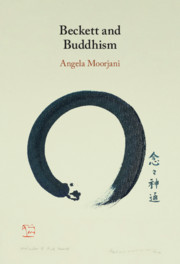20 results
Figures
-
- Book:
- Beckett and Buddhism
- Published online:
- 08 July 2021
- Print publication:
- 22 July 2021, pp viii-viii
-
- Chapter
- Export citation
Abbreviations of Editions Used
-
- Book:
- Beckett and Buddhism
- Published online:
- 08 July 2021
- Print publication:
- 22 July 2021, pp xi-xiv
-
- Chapter
- Export citation
Dedication
-
- Book:
- Beckett and Buddhism
- Published online:
- 08 July 2021
- Print publication:
- 22 July 2021, pp v-vi
-
- Chapter
- Export citation
Index
-
- Book:
- Beckett and Buddhism
- Published online:
- 08 July 2021
- Print publication:
- 22 July 2021, pp 232-238
-
- Chapter
- Export citation
References
-
- Book:
- Beckett and Buddhism
- Published online:
- 08 July 2021
- Print publication:
- 22 July 2021, pp 214-231
-
- Chapter
- Export citation
Chapter 8 - Dreaming ‘all away’ in the Final Texts
-
- Book:
- Beckett and Buddhism
- Published online:
- 08 July 2021
- Print publication:
- 22 July 2021, pp 191-213
-
- Chapter
- Export citation
Copyright page
-
- Book:
- Beckett and Buddhism
- Published online:
- 08 July 2021
- Print publication:
- 22 July 2021, pp iv-iv
-
- Chapter
- Export citation
Chapter 1 - Schopenhauer’s Buddhism Revisited: Recent Archival Evidence
-
- Book:
- Beckett and Buddhism
- Published online:
- 08 July 2021
- Print publication:
- 22 July 2021, pp 19-37
-
- Chapter
- Export citation
Chapter 3 - Buddhist and Mystic Threads in the Early Fiction
-
- Book:
- Beckett and Buddhism
- Published online:
- 08 July 2021
- Print publication:
- 22 July 2021, pp 64-87
-
- Chapter
- Export citation
Chapter 7 - Rebirth and the Buddhist Unborn in the Fiction and Drama
-
- Book:
- Beckett and Buddhism
- Published online:
- 08 July 2021
- Print publication:
- 22 July 2021, pp 161-190
-
- Chapter
- Export citation
Chapter 6 - The No-Self Staged and Voices from Elsewhere
-
- Book:
- Beckett and Buddhism
- Published online:
- 08 July 2021
- Print publication:
- 22 July 2021, pp 139-160
-
- Chapter
- Export citation
Introduction
-
- Book:
- Beckett and Buddhism
- Published online:
- 08 July 2021
- Print publication:
- 22 July 2021, pp 1-18
-
- Chapter
- Export citation
Chapter 5 - The Coincidence of Contraries and Noh Drama
-
- Book:
- Beckett and Buddhism
- Published online:
- 08 July 2021
- Print publication:
- 22 July 2021, pp 116-138
-
- Chapter
- Export citation
Contents
-
- Book:
- Beckett and Buddhism
- Published online:
- 08 July 2021
- Print publication:
- 22 July 2021, pp vii-vii
-
- Chapter
- Export citation
Chapter 2 - East–West Dialogue via Schopenhauer
-
- Book:
- Beckett and Buddhism
- Published online:
- 08 July 2021
- Print publication:
- 22 July 2021, pp 38-63
-
- Chapter
- Export citation
Acknowledgments
-
- Book:
- Beckett and Buddhism
- Published online:
- 08 July 2021
- Print publication:
- 22 July 2021, pp ix-x
-
- Chapter
- Export citation
Chapter 4 - Beckett’s Paradoxical Logic through Buddhist and Western Lenses
-
- Book:
- Beckett and Buddhism
- Published online:
- 08 July 2021
- Print publication:
- 22 July 2021, pp 88-115
-
- Chapter
- Export citation

Beckett and Buddhism
-
- Published online:
- 08 July 2021
- Print publication:
- 22 July 2021
2 - Molloy, Malone Dies,The Unnamable
- from Part I - Canon
-
-
- Book:
- The New Cambridge Companion to Samuel Beckett
- Published online:
- 05 February 2015
- Print publication:
- 12 January 2015, pp 19-32
-
- Chapter
- Export citation
Notes on Contributors
-
-
- Book:
- The New Cambridge Companion to Samuel Beckett
- Published online:
- 05 February 2015
- Print publication:
- 12 January 2015, pp ix-xii
-
- Chapter
- Export citation



